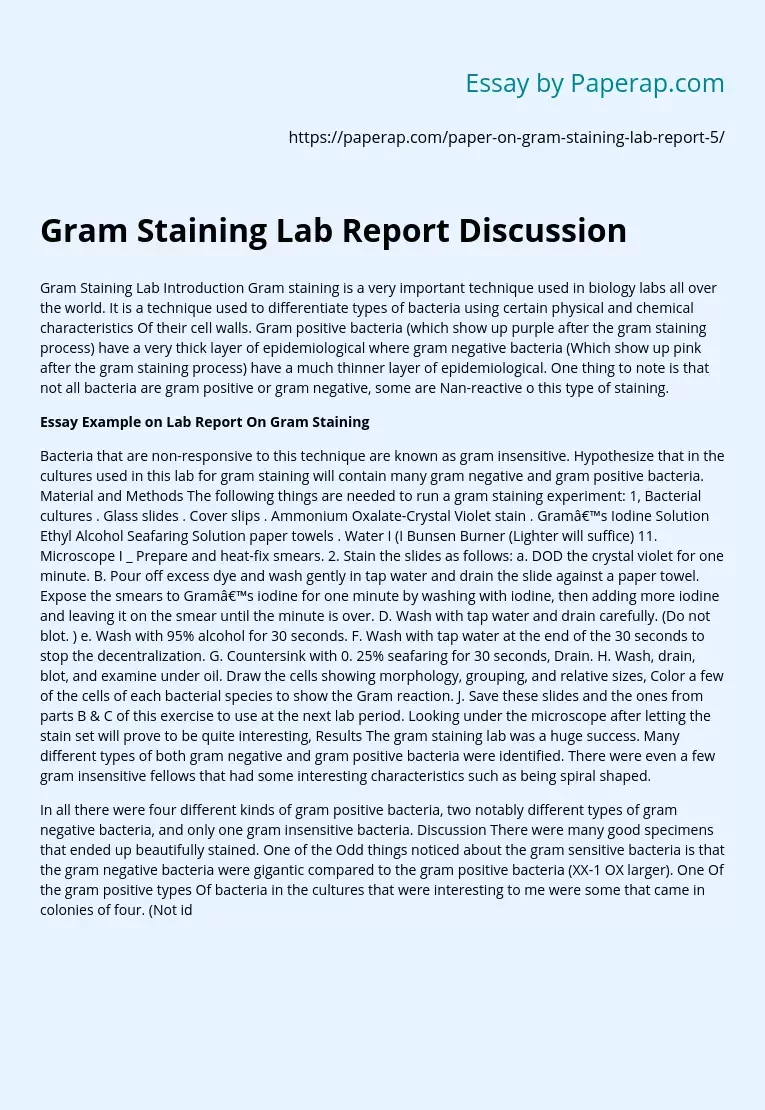Gram Staining Lab Report Discussion
Gram Staining Lab Introduction Gram staining is a very important technique used in biology labs all over the world. It is a technique used to differentiate types of bacteria using certain physical and chemical characteristics Of their cell walls. Gram positive bacteria (which show up purple after the gram staining process) have a very thick layer of epidemiological where gram negative bacteria (Which show up pink after the gram staining process) have a much thinner layer of epidemiological. One thing to note is that not all bacteria are gram positive or gram negative, some are Nan-reactive o this type of staining.
Essay Example on Lab Report On Gram Staining
Bacteria that are non-responsive to this technique are known as gram insensitive. Hypothesize that in the cultures used in this lab for gram staining will contain many gram negative and gram positive bacteria. Material and Methods The following things are needed to run a gram staining experiment: 1, Bacterial cultures . Glass slides . Cover slips .
Ammonium Oxalate-Crystal Violet stain . Gram’s Iodine Solution Ethyl Alcohol Seafaring Solution paper towels . Water I (I Bunsen Burner (Lighter will suffice) 11. Microscope I _ Prepare and heat-fix smears. 2. Stain the slides as follows: a. DOD the crystal violet for one minute. B. Pour off excess dye and wash gently in tap water and drain the slide against a paper towel. Expose the smears to Gram’s iodine for one minute by washing with iodine, then adding more iodine and leaving it on the smear until the minute is over.
D. Wash with tap water and drain carefully. (Do not blot. ) e. Wash with 95% alcohol for 30 seconds. F. Wash with tap water at the end of the 30 seconds to stop the decentralization. G. Countersink with 0. 25% seafaring for 30 seconds, Drain. H. Wash, drain, blot, and examine under oil. Draw the cells showing morphology, grouping, and relative sizes, Color a few of the cells of each bacterial species to show the Gram reaction. J. Save these slides and the ones from parts B & C of this exercise to use at the next lab period. Looking under the microscope after letting the stain set will prove to be quite interesting, Results The gram staining lab was a huge success. Many different types of both gram negative and gram positive bacteria were identified. There were even a few gram insensitive fellows that had some interesting characteristics such as being spiral shaped.
In all there were four different kinds of gram positive bacteria, two notably different types of gram negative bacteria, and only one gram insensitive bacteria. Discussion There were many good specimens that ended up beautifully stained. One of the Odd things noticed about the gram sensitive bacteria is that the gram negative bacteria were gigantic compared to the gram positive bacteria (XX-1 OX larger). One Of the gram positive types Of bacteria in the cultures that were interesting to me were some that came in colonies of four. (Not identified yet but have been working on it.
Gram Staining Lab Report Discussion. (2019, Nov 27). Retrieved from https://paperap.com/paper-on-gram-staining-lab-report-5/

